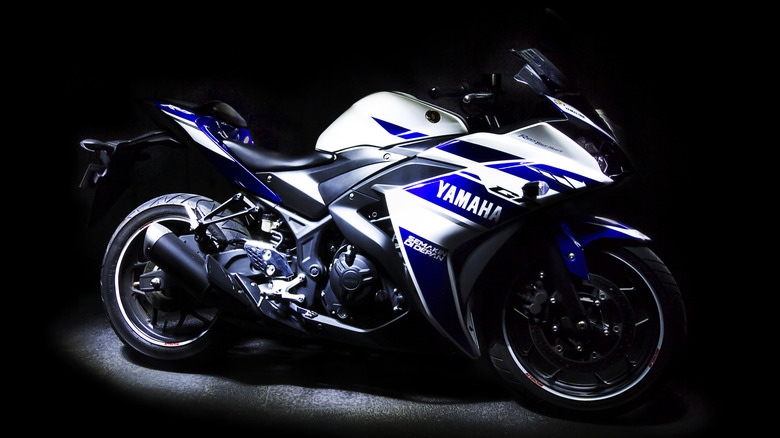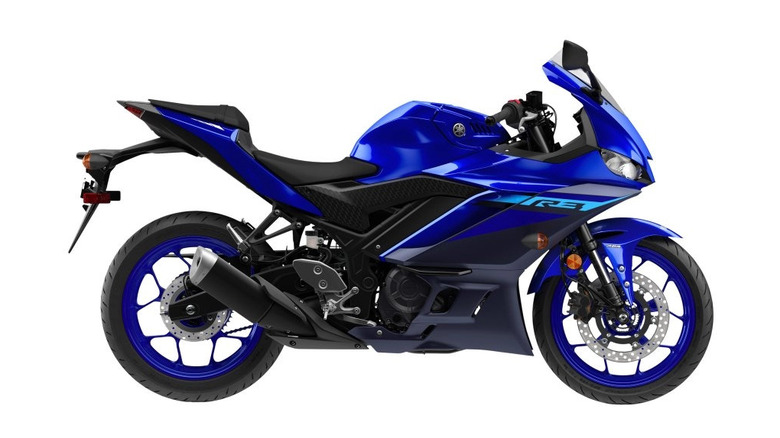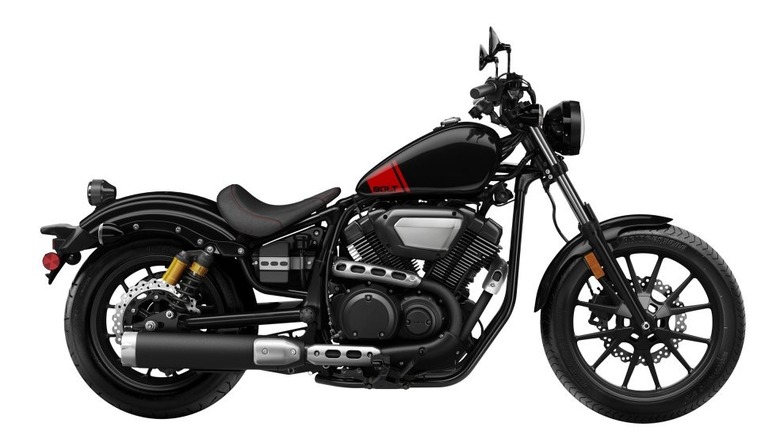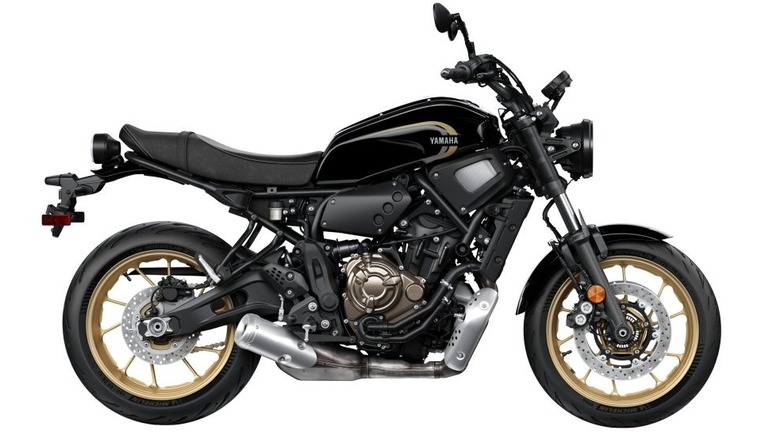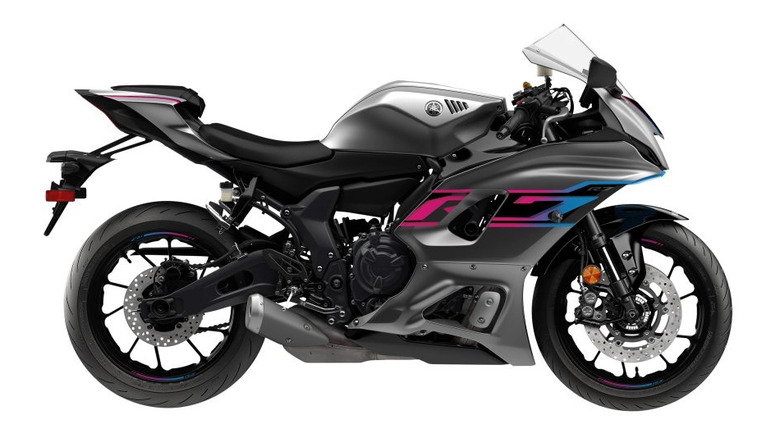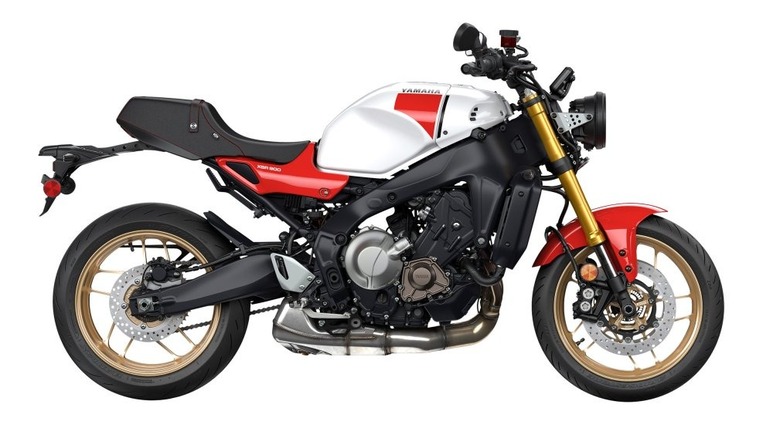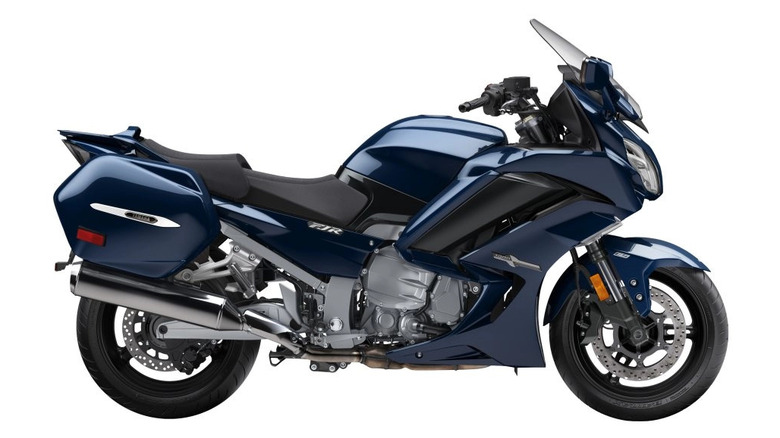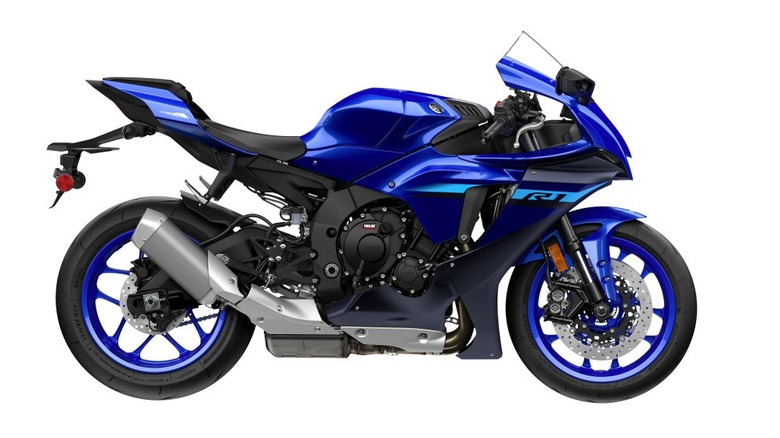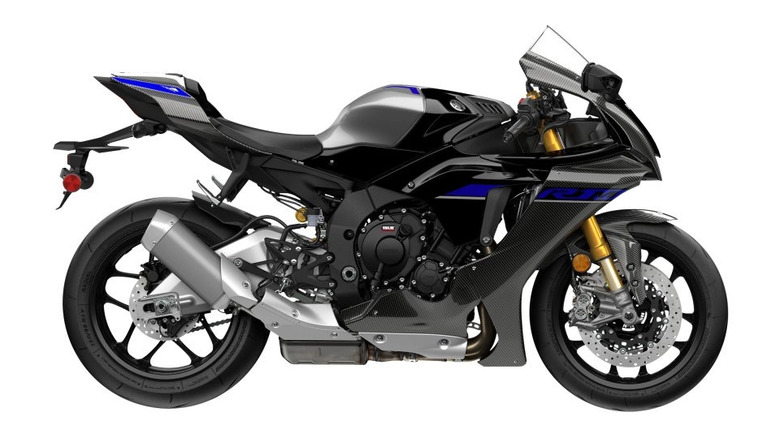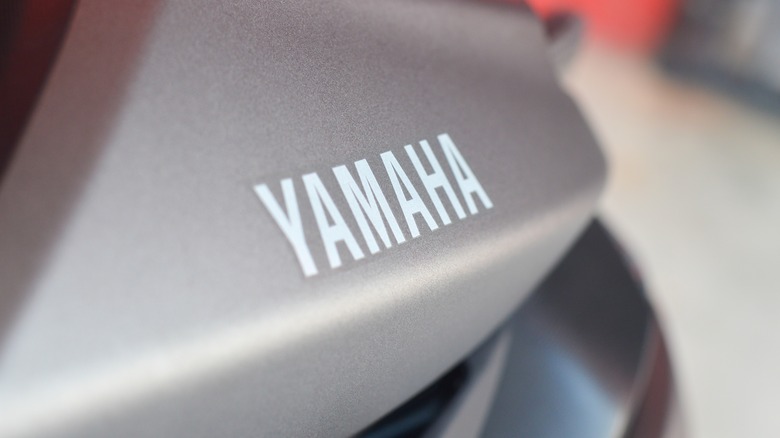Every Yamaha R-Series Motorcycle You Can Buy In 2024 Ranked Cheapest To Most Expensive
Torakusu Yamaha founded his titular company in 1887 to make reed organs and pianos. Although the Japanese conglomerate emerged just two years after the Daimler Reitwagen built what was considered the very first motorcycle, Yamaha wouldn't begin building bikes until 1955.
Yamaha's first attempt was the YA-1, a 125cc, two-stroke machine that proved a harbinger of what was to come for Yamaha after it won the first two races it entered. In 1970, Yamaha introduced its first four-stroke bike, the 650cc vertical twin XS-1. However, the engineers weren't resting on their laurels in the intervening years. Yamaha appeared in the Road Racing World Championship Grand Prix for the first time in 1961 and would score seven rider and constructor titles in the 250cc class over the next decade.
Since then, Yamaha has focused on racing perhaps more than any other of the big four builders. Between 1963 and 2021, blue bikes have taken 517 wins across all classes. By the late 1990s, the Kawasaki Ninja and Honda CBR had captured the hearts and minds of riders everywhere. Candy-colored supersports were all the rage and with good reason — the performance-to-cost ratio was out of proportion. A sportbike worth a few thousand dollars could smoke supercars that cost exponentially more. With a racing legacy to defend, Yamaha introduced its R-series line in 1998 with the YZF-R1.
In the quarter century since, Yamaha's R-bikes have garnered accolades from fans and championships in the hands of pros. Though things have changed in the sportbike world since 1998, Yamaha's R-designation is going strong. In 2024, Yamaha has an entire line of bikes that have earned the R-moniker. In honor of 25 years of performance, we look at every Yamaha R-series you can buy in 2024.
YZF-R3 $5,499
The 2024 YZF-R3 carries itself like its bigger siblings. It takes a discerning eye to tell that it's a smaller displacement bike. It looks downright mean, just as a sportbike should. Still, beneath all that menace, its heart may surprise you.
In place of the screaming in-line four-cylinder associated with supersports, a competent liquid-cooled DOHC 321cc parallel twin makes around 40 horsepower and 30 lb-feet of torque. The R3 will not send experienced riders into a tizzy of excitement, but it's also much less likely to send inexperienced riders over the high side. With a wet weight of 375 pounds and a saddle height of 30.7 inches, it's an entry into the R-world, an extended hand to new riders who, while enjoying the aesthetic and handling of sportbikes, were too intimidated, inexperienced, or physically restricted from handling the bigger bikes.
Before the mid-2010s, a rider who wanted a sportbike had two options in terms of displacement: 600cc or 1,000cc. So what if you were shorter than average? Or lighter. Or, god-forbid, simply wanted to enjoy a track day without worrying that a blip of the throttle would send your bike cartwheeling into the pits? The YZF-R3 is the answer to that question, but the begs another question – just how fast is the R3?
Will the R3 carry a rider through their entire career? Not likely. Even those who just want some weekend fun will eventually outgrow the R3. However, Yamaha's least-expensive R offers a chance to prepare for something bigger.
Bolt R-Spec $8,899
The Bolt R-Spec is next on the hierarchy of R-worthy Yamahas, and it is a fascinating departure from what most people associate with Yamaha's R-line. Yamaha announced the Bolt in 2013, rolling out the following model year with its standard Bolt and a Bolt-R.
Unlike the superports most commonly associated with the Yamaha R badge, the Bolt is more akin to a Harley-Davidson Sportster. Aimed at fans of sporty cruising, the air-cooled 942 cc single overhead cam V-twin provides torquey power delivery where the supersports don't. Considered a middleweight, it is sort of the anti-Sportster, with matte-black detailing on the areas of the bike Harley tends to drape with chrome. Even better, compared to a Harley, the price point is mighty favorable.
In past years, the R designation marked an upgraded suspension over the standard Bolt or Bolt-C models. In 2024, the R-Spec is the only Bolt in the line. Fans of V-twin cruisers have to go with the Bolt-R or drop to the 250cc V-Star, which is not in the same class as the muscular bobber.
While it's not going to beat an R1 around the track — or even come close — Yamaha has paid particular attention to timing maps and a low center of gravity to make the Bolt R-Spec a handler around town. Beyond that, there's just something so charming about a grunty V-twin piling on speed in any gear. The Bolt R-spec is in your wheelhouse if you are a Yamaha fan with a penchant for V-twin cruising.
XSR-700 $8,899
Classed in the same sport heritage category as the Bolt R-Spec, the XSR series of naked street fighters have an entirely different appeal. Initially launched in 2016, the XSR line aims at fans of retro design in a powerful performance package.
The XSR700, inspired by the XS650 of the 1970s, is a significantly improved over the YZF-R series from a rider's perspective, with eased back handlebars, an upright riding position, and a forgiving saddle. Still, even experienced riders should find something to like about the 689cc cross-plane crank in-line twin cylinder that emphasizes pulling torque from all over the power band.
The bike is simple without being overly so. It lacks some of the complicated technical wizardry of modern top-of-the-line sport cruisers like Yamaha's premier sport-touring FJR1300. Honestly, though, that's a big part of the charm. An anti-lock brake system paired with 298mm four-piston front brakes pulls it to a stop. The single, round information gauge provides a plethora of information at a glance of its digital face.
With motorcycles (and everything else in the world) growing more complex by the year, the XSR700 is an uncomplicated, competent break from the world of ultra-fast, high-stakes riding we're used to from the Yamaha R-line. The XSR700's upshot is in-line twin power delivery in a bike that will keep a beginner in the seat and an experienced rider in the twisties.
YZF-R7 $9,199
Yamaha discontinued the legendary YZF-R6 in 2020 after European Union emissions regulations made selling the beloved supersport untenable. If you think the YZF-R7 is its replacement, you're wrong –- sort of. The R7 won't do what the 116 horsepower, 162 mph top speed Yamaha R6 did, but that's not necessarily a bad thing.
Debuting in 2021, the R7 is like a cross between the R3 and the R6. Gone is the in-line four, replaced by a 689cc, DOHC twin-cylinder that makes around 75 horsepower. Those stats alone should tell you that the R7 is a very different beast than its predecessor. Yamaha is basically saying that if you want an insane race bike, pick one of the R1 models. However, if you want to enjoy a sharp handling machine that may not immediately invoke heart failure in your insurance agent, check out the new, more approachable breed of Yamaha.
That's not to say that the R7 isn't worthy of the R-designation. The design alone tells us what we want to know. It's aggressive and as razor-sharp as its handling. With a six-speed multi-plate clutch, adjustable suspension, and lightweight suspension. The R7 should have everything a rider needs from beginner to advanced. It is a middleweight's middleweight, an offering alongside Honda's CBR650 or Kawasaki's 650. These bikes represent the industry's response to the desire for manageable sport riding.
XSR-900 $10,299
At first glance, the XSR900 looks like the bigger sibling of the XSR700. After all, it's common for builders to offer bikes across the spectrum to satisfy riders' needs. However, one crucial difference sets it apart from modern motorcycles. Unlike the XSR700 and its parallel twin, the XSR900 has a three-cylinder powerplant.
The 890cc DOHC engine employs the same cross-plane crankshaft technology as its little sibling, but with more significant displacement spread across three cylinders, it is more powerful. While Moto2 racing exclusively uses three-cylinder bikes, they are rare on the street. Linear torque delivery and reduced vibration are advantages of triples over twins, but they also require counterbalancing weights and are not as smooth as four-cylinders.
The 2024 XSR900 has an estimated 119 horsepower at 10,000 RPM – still shy of the 2020 YZF-R6 mark but lower in the powerband. In a three-cylinder configuration, that power is delivered much differently than in a race-bred 4-cylinder.
The XSR-900 is packaged in a way that doesn't preclude those of us who have already misspent a youth on the supersports from enjoying a ride that lasts longer than half an hour. Every big bike company has its take on the naked street fighter, but stylistically, the XSR line already stands on its own. Handsome, powerful, and idiosyncratic enough to stand out from the crowd, the XSR900 has been around since 2016 and doesn't show signs of slowing.
FJR-1300ES $18,299
Yamaha has been producing its premier sport-touring flagship, the FJR-1300, since 2001. With decades of experience, the 2024 ES edition represents the latest and greatest in Yamaha's development of sport-tourers.
With a wet weight of 642 pounds, the FJR is undoubtedly not a lightweight racebike in the same category as the YZF-R series, but it's not supposed to be. Wringing every possible horse out of this engine is not what Yamaha is going for. Just the same, the FJR has plenty. With a big-bore 1,300cc in-line four making 142 horsepower, it is the most potent Yamaha motorcycle in the 2024 lineup on this side of the R1.
In its quest to put the cruise in a sports cruiser, Yamaha includes a selection of premium features, including seating that is comfortable for both rider and passenger. Electronically adjustable suspension, 6.6-gallon fuel tank, ABS, cruise control, traction control, adjustable ergonomics, and available hard luggage and fairing mounts emphasize that with the FJR, you can drag a knee during the week and enjoy a road trip on the weekends.
YZF-R1 $18,399
We've arrived at the bike that started it all — the YZF-R1. This bike first appeared in 1998 to disrupt the supersport apple cart, and it quickly accomplished its mission in spades. With the Kawasaki Ninja, Honda CBR, and Suzuki GSX-R pushing the envelope, Yamaha cannonballed into the pool with a bike that set the standard for the next 25 years.
In 2024, the YZF-R1 is going strong. Though only $100 more than the FJR, it has a different mission. Everything about the R1, from its 998cc liquid-cooled DOHC engine to the Bridgestone Battlax Racing tires is about getting around the track the fastest. You can ride it on the street, but a bike like this can't come close to its full potential anywhere near a stoplight.
This is an expert bike for expert riders. Don't believe me? Consider 198 horsepower pushing 448 pounds. Do the math, and you come up with a power-to-weight ratio of about 1000 horsepower per ton. That's fastest car in the world territory. Without a steel cage. Or airbags. And an inch-long throttle pull laying all that power to a single wheel.
The brinksmanship of building the fastest bike in the world has been pushing the big four Japanese builders to outdo each other year after year. Though Kawasaki's purpose-built H2R is the current king of the hill, the R1 is not to be trifled with. Buyer beware. This is one serious piece of machinery. What's cooler than that?
YZF-R1M $27,399
So you read the write-up on the R1 and shrugged. You're an expert rider with tons of experience on and off the track, and, quite frankly, the liter bikes have become a little... yawn. They're fast and all, but you want to shave every thousandth of a second off your lap time. Yamaha has one more bike to throw your way — the YZF-R1M.
The price difference is substantial. So, what do you get for the additional $9,000? We've previously covered the differences between these top-tier supersport bikes, but if you're short on time we can answer with a single word: suspension. Adding the R to motorcycle names has long been the standard for indicating a race bike, but the R1M is genuinely a track beast.
The R1M swaps the KYB suspension for an Ohlins system, including a 43mm electronic NPX front fork and pressurized nitrogen chamber in the rear for superior dampening. The system monitors conditions during a ride and adjusts to keep the bike in optimal fit on the track. Full carbon fiber bodywork and a GPS data logging unit really emphasize this bike's role as a track monster. It gives riders technology that we often only see in professional moto racing.
If the R1 isn't for everybody, the R1M is even more specialized. It is equally rideable on the street, but those shelling out the extra cash are likely looking to spend some time hitting the apex on the weekends.
Methodology
The rule of thumb for motorcycles is the more Rs in the name, the faster it is. The R stands for "race" or "race replica." Yamaha has made a name for itself as one of the premier superport motorcycle producers with its YZF-R6 and YZF-R1. The big four producers, Suzuki, Honda, Kawasaki, and Yamaha, have been expanding the r-designation to models on which they concentrate on producing performance-oriented bikes. As such, we decided to take a comprehensive look at every model Yamaha awarded the R-designation in 2024. By organizing them by price, which tends to correspond with displacement, we can get a good look at bikes for every budget and skill level.
